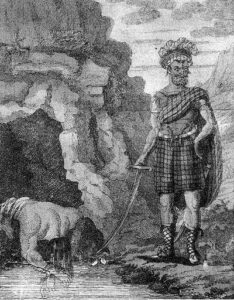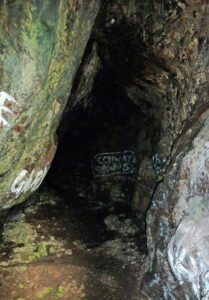
Scotland late 1800’s a popular ghost story was doing it rounds in the local area one famous writer in his book mentions The tale concerning Sawney Bean, a celebrated seventeenth-century murderer who ate his victims. Bean was thus famous in the history of Scottish folklore as instances of cannibalism are rare north of the Tweed/Solway line.
Sawney Bean, the cave-dwelling cannibal, is one of Scotland’s most shocking and gruesome legends. Sawney Bean was said to be the head of an incestuous cannibalistic family, who oversaw a 25-year reign of blood, murder and robbery from a hidden cave on the Ayrshire/Galloway coastline in the 14th century. There are numerous written sources detailing the account of Sawney and his family, and it has been suggested that the legend has its roots in real events. Little is known for certain about his early life, however Sawney Bean is believed to have been born in East Lothian in the late 13th century, and was a tanner by trade. Yet, while the story itself was gory enough, it has often been thought to have an even more sinister subtext. Despite being set in Scotland, the gruesome deeds of Sawney Bean were popularised in England during the 17th and 18th centuries, at a time when there was widespread prejudice against Scots. At the time of the Jacobite risings in the 18th Century, the English press regularly portrayed Scots in a negative way, either as subjects of ridicule or as having a sinister nature (the name Sawney itself was a popular English name for the barbarous cartoon Scot). But just how much truth was there to this sinister legend?

The exploits of Sawney Bean were said to have taken place on the usually idyllic south-west coast of Scotland. The most commonly told account of Sawney Bean begins in East Lothian where Alexander “Sawney” Bean, the son of a ditch-digger and hedger, came to realise that labouring in the family business, and indeed labour in general, was not to his taste, leading to his departure for the south-west coast of Scotland. After leaving his home and travelling to South Ayrshire, Bean found companionship with a woman, sometimes named Black Agnes Douglas, who shared his disinterest in an honest living. A remote coastal cave, located between Girvan and Ballantrae, is said to be where the couple took up residence. The Beans survived undiscovered for 25 years in this setting and populated the cave with a 45-strong incestuous brood. They carved a monstrous living ambushing travellers on the road, whether individuals or small groups, robbing them of their possessions, and murdering them before dragging their bodies back to the cave where they would be dismembered and eaten. As body parts began washing up on nearby beaches and the larger disappearances were noticed by nearby villagers, the secretive Beans managed to evade detection during the investigations and scapegoats were falsely accused and lynched to appease the mob.
The horrific Bean clan finally came unstuck when they set upon a man coming back from a fair who fought them off and escaped to tell the tale. The cannibals were reported to the magistrates of Glasgow who, in turn, informed King James. With their existence reported, a search party consisting of over 400 men with bloodhounds (and supposedly led by King James himself) was dispatched to apprehend the clan. Eventually the bloodhounds led the party to the cave and the conviction grew that this was the place for which they were searching. Awaiting inside the cave lay a gruesome scene of gore and filth; body parts were both pickled in jars and hung from the walls, while possessions of the victims were unceremoniously left in piles. Finally captured, Sawney Bean and his family were taken alive and bound in chains to the Tolbooth in Edinburgh to await their execution. The women and children of the clan were burned at the stake while – in a barbaric echo of the cruelty experienced by their victims – the men were themselves dismembered and allowed to bleed to death.
Historians may dispute the existence of Sawney Bean and his family but the general public have never lost their appetite for this Caledonian cannibal legend. The horror of the Sawney Bean legend continues to intrigue, with an exhibit at the popular Edinburgh Dungeon attraction being devoted to the legend. Meanwhile an international audience might recognise the story of an incestuous family of cannibals capturing and feasting on the flesh of travellers from Wes Craven’s 1977 film The Hills Have Eyes. Craven was inspired by an article on Sawney Bean that he read in the New York library. Its influence can also be seen in The Texas Chainsaw Massacre. Terrifying though it may be, it must be emphasised that there is absolutely no proof that Sawney Bean ever existed. Historical documents, such as newspapers and diaries during the era when Sawney Bean was supposedly active, make no mention of ongoing disappearances of hundreds of persons. But, while there are inconsistencies in the stories, it is possible that kernels of truth might have inspired the legend. The Sawney Bean legend also closely resembles the story of Christie-Cleek, which is attested much earlier – in the early 15th century – but takes place in the same general location. Perhaps, then, this is just a popular tradition in an area where the gory tale incites an interesting mixture of pride and shame among the locals. Or perhaps it is something far darker – a warning that captures the essence of a far more sinister side of Scotland – one that outsiders would do well to be wary of.

Bean’s ghost is said to haunt the family’s cave beneath Bennane Head, north of Ballantrae. Here the Beans had taken up residence when Bean’s common-law wife, Black Agnes Douglas, had been driven out of Ballantrae as a witch. For twenty-five years, folklore says, they and their family lived in the cave and survived by eating the cadavers of waylaid travellers.
At last King James VI and I sent a posse of men with bloodhounds to flush them out, and in the cave the posse discovered human limbs hanging from the roof and an assortment of mortal flesh pickled in barrels. Bean, Agnes and their forty-six assorted family were rounded up and taken to Edinburgh for execution. Before he died, Bean put a curse on the cave and thereafter strange incidents have been recorded nearby. Even up to modern times the police have logged reports from drivers along the nearby roads having to break sharply to avoid ghostly figures.
Haunting Nights are looking to getting you closer to this story in 2021 and will be part of our “KILLER WALKS” Ghost Adventures.


